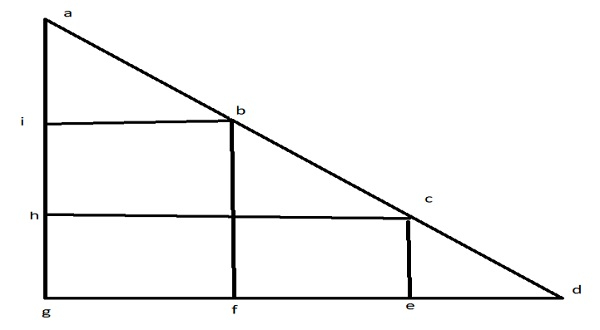
 Data Structure
Data Structure Networking
Networking RDBMS
RDBMS Operating System
Operating System Java
Java MS Excel
MS Excel iOS
iOS HTML
HTML CSS
CSS Android
Android Python
Python C Programming
C Programming C++
C++ C#
C# MongoDB
MongoDB MySQL
MySQL Javascript
Javascript PHP
PHP
- Selected Reading
- UPSC IAS Exams Notes
- Developer's Best Practices
- Questions and Answers
- Effective Resume Writing
- HR Interview Questions
- Computer Glossary
- Who is Who
Maximum number of 2×2 squares that can be fit inside a right isosceles triangle in C
We are given a right isosceles triangle. Isosceles triangle is the one which has two sides of equal length. Right triangle is the one which has height(ag in fig.) and base (dg in fig.) perpendicular to each other. The goal is to find the maximum number of squares that can fit into this right isosceles triangle of side 2 sq units. The sides base or height (both equal) are taken as input. No. of squares is output.
Refer to the below figure to understand the problem

The given triangle of height ag and base gd has 3 squares of side 2 each. From the corner ends ‘a’ and ‘d’, triangles aib and cde would never contribute to any square. So first we will always need extra 2 units of length for these triangles. No we have to divide remaining base gd( or height ag) by 2 to count no. of squares. Same will be the case with height ( ag ).
while(base > 2 ) squares+=(base-2)/2 base = base-2. Use formula of Ap = b*(b+1)/2….where new b=b-2
Let’s understand with examples.
Input − Base: 12
Output − Count of squares : 15
Explanation
base 12>2, squares 10/2=5, new base 12-2=10 base 10>2, squares 8/2=4, new base 10-2=8 base 8>2, squares 6/2=3, new base 8-2=6 base 6>2, squares 4/2=2, new base 6-2=4 base 4>2, squares 2/2=1, new base 4-2=2 base 2>2 X Total squares=5+4+3+2+1=15
Input − .5
Output − Count of squares − 1
Explanation
base 5>2, squares 3/2=1, new base 5-2=3 base 3>2, squares 1/2=0, new base 3-2=1 base 1>2 X Total squares=1
Approach used in the below program is as follows
The integer variable base is used to store the Base of triangle..
Function numofSquares(int b) is used to count the number of squares that triangle with base b can accommodate.
At first b=b-2 −extra space from corner ends
According to formula, b=floor(b/2), this new b can have b*(b+1)/2 squares of side 2.
Return the calculation as the number of squares.
Example
#include <stdio.h>
#include <math.h>
int numofSquares(int b){
// removing the extra part we would
// always need
b = (b - 2);
// Since each square has base of
// length of 2
b = floor(b / 2);
return b * (b + 1)/2;
}
int main(){
int base = 8;
printf("Maximum no. of square that can be accommodated : %d",numofSquares(base));
return 0;
}
Output
If we run the above code it will generate the following output −
Maximum no. of square that can be accommodated : 6

